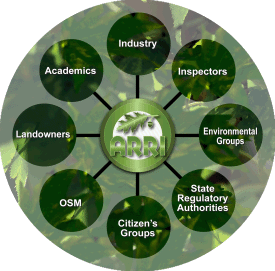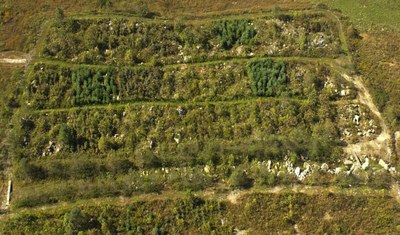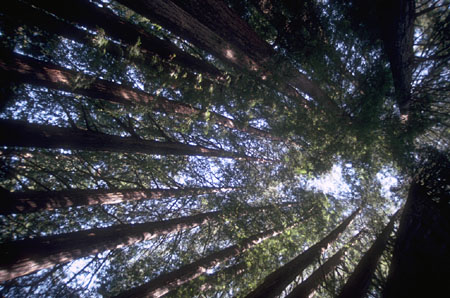ARRI and the Appalachian LCC
ARRI is a coalition within the Office of Surface Mining Reclamation and Enforcement (OSM), which is responsible for establishing a nationwide program to protect society and the environment from the adverse effects of surface coal mining operations while balancing the nation’s need for continued domestic coal production. OSM has been an integral part of the Appalachian LCC Steering Committee. In this role, OSM was a major partner in developing the governance structure, the mission and vision of the Cooperative, and helping to oversee the first project funding decisions.
ARRI is an Award-winning Initiative
 ARRI is proud to be the recipient of the following prestigious awards: ARRI is proud to be the recipient of the following prestigious awards:
- Partners in Conservation Award from the Secretary of the Interior; Awarded on October 18, 2012
- Presidential Migratory Bird Federal Stewardship Award; Awarded on May 25, 2011
- 2011 Arbor Day Award from the National Arbor Day Foundation; Awarded on May 10, 2011
- Cooperative Conservation Award from the Secretary of the Interior; Awarded on May 9, 2007
These awards were made possible through the hard work of the ARRI Core and Science Teams and the hundreds of individuals and representatives of industry, environmental groups, academic institutions, citizen’s groups, landowners and federal, state and local government who have worked to implement the Forestry Reclamation Approach when planting trees throughout Appalachia.
|
FORESTRY RECLAMATION APPROACH
 Create a suitable rooting medium for good tree growth that is no less than 4 feet deep and comprised of topsoil, weathered sandstone, and/or the best available material Create a suitable rooting medium for good tree growth that is no less than 4 feet deep and comprised of topsoil, weathered sandstone, and/or the best available material- Loosely grade the topsoil or topsoil substitutes established in step one to create a non-compacted growth medium
- Use ground covers that are compatible with growing trees
- Plant two types of trees – 1) early succession species for wildlife and soil stability, and 2) commercially valuable crop trees
- Use proper tree planting techniques
Brochures & Forest Reclamation Advisories
 Brochures Brochures
Reforestation for Appalachia's Wildlife
Appalachian Regional Reforestation Initiative - Trees for Appalachia's Future
ARRI's First 5 Years [October 1, 2009]
Forest Reclamation Advisories
Forest Reclamation Advisory No. 9 - Selecting Tree Species for Reforestation of Appalachian Mined Land [Click here to open Excel File]: More than 100 native tree species and numerous native shrub species grow within Appalachian forests. This diversity reflects the many site conditions found across the region. [August 2012]
Forest Reclamation Advisory No. 8 - Selecting Materials for Mine Soil Construction When Establishing Forests On Appalachian Mine Sites: When native forest re-establishment is the post-mining land use and reclamation goal, the guidelines reviewed in Advisory No. 8 can aid mine operators in ensuring that mine soils, applied at a minimum of 4 feet in thickness, will restore land capability and support forest growth and diversity at pre-mining levels. [July 2011]
Forest Reclamation Advisory No. 7 - Planting Hardwood Tree Seedlings on Reclaimed Mine Land in Appalachia: Proper care and planting of tree seedlings is essential to any reforestation effort. Appalachian coal mines reclaimed using the FRA will often be rough, rocky, and on steep terrain. Thus, hand planting is the usual method for planting hardwood tree seedlings. This Advisory describes the fifth step of the FRA: Use proper tree planting techniques. [February 2010]
Forest Reclamation Advisory No. 6 - Tree Compatible Groundcovers for Reforestation and Erosion Control: The FRA uses a slow growing, noncompetitive, tree-compatible ground cover. Advisory No. 6 addresses FRA’s 3rd step and describes methods for establishing ground cover vegetation to control erosion without hindering the survival and growth of the trees planted. [July 2009]
Forest Reclamation Advisory No. 5 - Mine Reclamation Practices to Enhance Forest Development Through Natural Succession: Succession is a term used to describe natural changes in plant community composition over time. This advisory describes the ways in which reclamation methods can encourage rapid succession and accelerate development of high quality postmining forests. [July 2007]
Forest Reclamation Advisory No. 4 - Loosening Compacted Soils on Mined Sites: Some areas of mine sites become compacted due to machinery operation, traffic, and storage. This advisory describes practices for ripping compacted areas so as to loosen soils necessary to achieve successful reforestation. [July 2007]
Forest Reclamation Advisory No. 3 - Low Compaction Grading to Enhance Reforestation Success on Coal Surface Mines: This advisory describes final-grading techniques that can be used during reclamation to prepare coal-surface mines to support a forested postmining land use. [July 2007]
Forest Reclamation Advisory No. 2 - The Forestry Reclamation Approach (FRA): The FRA is the science-based technique for reclaiming coal-mined land to forest while complying with the existing State and Federal mining laws. This advisory explains the 5 steps of the FRA. [December 2]
Forest Reclamation Advisory No. 1 - The Appalachian Regional Reforestation Initiative: In this first advisory, the goals of ARRI and the function of these Forest Reclamation Advisories are explained. [December 2005]
|


 Create a suitable rooting medium for good tree growth that is no less than 4 feet deep and comprised of topsoil, weathered sandstone, and/or the best available material
Create a suitable rooting medium for good tree growth that is no less than 4 feet deep and comprised of topsoil, weathered sandstone, and/or the best available material



















